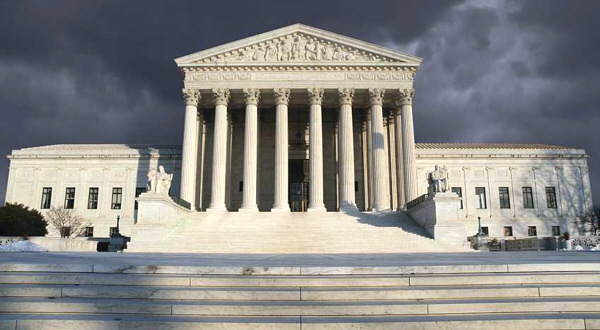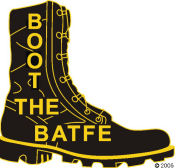

SCOTUS Considers PLCAA As
Anti-Gun Lawfare Returns With a Vengeance

By John Commerford. May 8, 2025
Article Source
As we approach the 20th anniversary of the Protection of Lawful Commerce in Arms Act's (PLCAA) passage coming up on Oct. 26, the law is imperiled by a new generation of anti-gun litigants seeking to exploit loopholes. In March, however, one such case—Smith & Wesson Brands v. Estados Unidos Mexicano—landed before the U.S. Supreme Court, where it received a chilly reception from skeptical justices across the ideological spectrum.
Most observers believe the plaintiffs overplayed their hand, although the reasoning the justices use to resolve the case will determine whether the PLCAA continues to protect the law-abiding gun industry as intended.
The PLCAA is ultimately about how the industry that enables Americans' Second Amendment rights is regulated. Is it by relatively fixed and ascertainable statutes enacted by democratically elected legislators? Or is it by unpredictable, shifting and innumerable standards of "reasonableness" imposed after the fact by unelected judges at the behest of firearm prohibitionists?
That latter option promotes lawfare, which has been characterized as death by a thousand cuts. Lawfare practitioners may not care if they win their cases, because even one who is innocent before the law can succumb to the legal process itself.
The biggest cut is the expense of litigation. The lengthier and more complex the proceedings, the more likely the defendant will be unable to sustain a defense.
Another is reputational harm from accusations of wrongdoing, no matter how baseless, particularly if the media and public officials amplify the plaintiff's case.
A third cut is the embarrassment or competitive disadvantage of having one's private or business affairs aired in court. At the "discovery" phase of litigation, plaintiffs can demand, and courts can order, the release of records or communications never meant for public disclosure. Once they enter the record or get leaked to the media, they can be distorted, misreported or otherwise used against the defendant.
Yet a fourth cut is the time, effort and travel expended on litigation. Defendants can be forced to spend hours, days or weeks away from their families, businesses or jobs in meetings, depositions and courtrooms. These opportunity costs are unrecoverable.
Lawfare that involves multiple plaintiffs from multiple jurisdictions ganging up on the same target is especially devastating. The involvement of public entities makes it even worse.
There are very few safeguards from unscrupulous litigation. A defendant can be targeted because of what it represents to an activist or simply because it has enough resources to pay a potential judgment. Lawfare can also be a way of shifting blame from the plaintiff to the defendant.
The legal profession is self-policing. Attorneys are rarely sanctioned for frivolous claims. Litigants usually bear their own costs, even against false allegations; remedies for that involve more court proceedings. Defense lawyers demand payment, win or lose. Their financial incentives, moreover, do not always align with their clients'.
These factors were all part of the public-private campaign to attack the firearm industry through the courts in the 1990s. The playbook had been perfected through the anti-tobacco and anti-smoking campaigns of the 1970s and '80s, which included massive lawfare, public health and propaganda elements. This crusade made cigarettes, in the words of one activist, "dirty, deadly and banned." It also upended the tobacco industry, forcing it to accept sweeping concessions on the sales and marketing of its products beyond those set through the legislative process.
Activists believed they could achieve the same results against guns, using the same methods, and even the same activists, judges and public officials.
Yet, this campaign did not involve an addictive, unavoidably unhealthy product but, rather, lawful arms protected by the U.S. Constitution. Unlike cigarettes, societal harms involving firearms were not caused by their routine, intended and lawful use, but through their misuse by criminals who obtained and wielded them unlawfully.
These distinctions didn't dissuade anti-gun activists.
It was the industry, so they claimed: that designed their guns with criminal use in mind; that flooded the market with more guns than there were legitimate buyers; that refused to make their guns "smarter," safer or more childproof; that glamorized guns and marketed them to unsuitable users through movies, television, music and video games; that turned a blind eye to lax or corrupt business practices; and that opposed every "reasonable gun-violence prevention measure" introduced by "gun-safety advocates."
It was the industry, they insisted, that "had blood on its hands."
Big-city mayors (many soft on actual criminals) gladly enumerated the ways "gun violence" burdened the taxpayers of their jurisdictions and created a "public nuisance."
It was much more difficult, however, to sustain these accusations in a court of law than in the court of public opinion. What the cases showed was that the firearm industry was already heavily regulated and that its members overwhelmingly followed the rules and acted in good faith.
Rarely were the plaintiffs' accusations of predatory behavior backed by criminal or administrative proceedings against the businesses. Rarely could plaintiffs prove criminal intent.
Multiple crimes by multiple criminals (thefts, unlawful transfers, unlawful possession, etc.) usually occurred between the time a gun was lawfully sold and when it was finally used, often years later, to harm someone.
If it was foreseeable that some guns would end up being misused, the same could be said about other consumer products, from alcohol to automobiles to sporting goods.
The cases were usually losers, but even losing cases that lasted long enough could cripple an industry.
This is why the states and, finally, Congress passed legislation to stop these suits at the earliest possible stage.
Indeed, the PLCAA was broadly bipartisan. Fifty-nine Democrats and one Independent voted for it in the House. Fourteen Democrats and one Independent voted for it in the Senate. For years, it worked as intended and kept these cases out of courts. Eventually, anti-gun activists turned their attention to other tactics.
There were so many things wrong with these arguments that it was difficult for the justices to coalesce around a majority view of the biggest flaw.
Yet, Congress was focused on preventing vicarious liability, not excusing bad actions by industry members themselves. It therefore exempted from the PLCAA's protection "an action in which a manufacturer or seller … knowingly violated a State or Federal statute applicable to the sale or marketing of the product, and the violation was a proximate cause of the harm for which relief is sought." The act's examples make clear the relevant laws are those passed specifically to regulate the gun industry. This has become known as the "predicate exception."
A new generation of lawfare activists nevertheless hope to shoehorn ever-broader theories of liability into that narrow exception. Their big breakthrough came in the 2019 case of Soto v. Bushmaster, in which the Connecticut Supreme Court validated the use of a state law banning "unscrupulous" advertising (which had never been used against a gun company) as a predicate statute. That case set the stage for the bankruptcy of Remington Firearms and provided a roadmap for anti-gun activists to find (or legislatively enact) new predicate exceptions.
Fast-forward to August 2021, when American gun-control activists teamed up with the government of Mexico to sue U.S. gun companies for crimes that armed drug cartels were committing south of the border. Not only did these activists collaborate with a foreign sovereign against their own countrymen and Constitution, but with one known for its own corruption, ineptitude and human-rights abuses.
This time, the gun companies' alleged "predicate offense" was "aiding and abetting" the straw purchases and other smuggling crimes that happened after the guns left their factories. Yet, Mexico did not claim the companies directly violated any provision of the Gun Control Act (GCA).
Instead, Mexico faulted the companies for lawfully making guns that are supposedly irresistible to cartels and for not adopting measures above and beyond the GCA's requirements to thwart the cross-border gun trafficking the industry knew was happening. Those measures, coincidentally, mirrored the terms of failed federal gun-control legislation.
There were so many things wrong with these arguments that it was difficult for the justices to coalesce around a majority view of the biggest flaw.
The industry members' attorney argued that even if everything the plaintiffs said were true, they had not claimed the industry violated the law or had not connected the dots between any alleged violations and harms more obviously caused by the cartel members. The complaint, in other words, failed on its face. Several justices seemed to agree.
But two justices, Amy Coney Barrett and Ketanji Brown Jackson, suggested the plaintiffs had not identified a proper predicate exception to the PLCAA, because aiding and abetting is not specific to the gun industry.
The industry members could prevail on either theory. A win on the predicate exception, however, could close the door to future lawsuits left wide open by Soto v. Bushmaster.
Justice Brown Jackson understood the PLCAA's intent: to ensure legislators, not judges, regulate the gun industry and to ensure companies that follow those regulations are not held responsible for criminals' independent misuse of guns. That protects all Americans' Second Amendment rights.
Hopefully, at least four other justices agree.
![]()
























